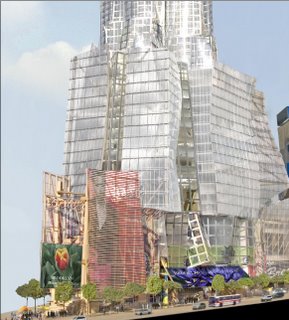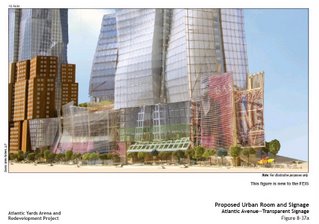The Sports Business Journal article published Monday on six founding partners for the planned Barclays Center arena said the Nets promise “street to seat brand domination.”
 “We’ll have very little static signage,” [Nets CEO Brett] Yormark said. “From the street or subway to the marquee and inside the bowl, only one brand will be visible at a time. The marketers we are talking to want fewer relationships that are more dominant. [Building architect] Frank Gehry did not want to overcommercialize this building, but he wanted to provide ownership for those brands that want to get involved.”
“We’ll have very little static signage,” [Nets CEO Brett] Yormark said. “From the street or subway to the marquee and inside the bowl, only one brand will be visible at a time. The marketers we are talking to want fewer relationships that are more dominant. [Building architect] Frank Gehry did not want to overcommercialize this building, but he wanted to provide ownership for those brands that want to get involved.”
Also, there will be a “construction activation platform” with signage, countdown clocks and other media in which partners will be identified.
 However, the new renderings (above) produced by Gehry show no commercial signage (nor "construction activitation platform"), even though signs could be 150 feet high and 75 feet wide. Also, Gehry once wanted to make sure that arena signage had a social function, used for art and community purposes, but that has fallen by the wayside. And the developer has pledged that signage would be relegated to games, a promise that deserves further scrutiny.
However, the new renderings (above) produced by Gehry show no commercial signage (nor "construction activitation platform"), even though signs could be 150 feet high and 75 feet wide. Also, Gehry once wanted to make sure that arena signage had a social function, used for art and community purposes, but that has fallen by the wayside. And the developer has pledged that signage would be relegated to games, a promise that deserves further scrutiny.
(Above, a rendering released yesterday with the relaunch of the Barclays Center web site suggested some signage. It also is marked "EmblemHealth Entrance" after an existing and promised sponsor.)
More from the state's reports
 Renderings in the Draft Environmental Impact Statement didn't show much signage, but at least they showed more than the developer has produced. (There's no signage in either the 2006 Image Gallery or the 2008 Image Gallery on the official Atlantic Yards web site.) The graphic at right by BrooklynSpeaks is adapted from two separate renderings in the Atlantic Yards Final Environmental Impact Statement (FEIS). As with the graphic below from the FEIS, it's tough to get a sense of the scale from ground level, but we can assume that the signage would be a lot more noticeable to someone walking or driving by.
Renderings in the Draft Environmental Impact Statement didn't show much signage, but at least they showed more than the developer has produced. (There's no signage in either the 2006 Image Gallery or the 2008 Image Gallery on the official Atlantic Yards web site.) The graphic at right by BrooklynSpeaks is adapted from two separate renderings in the Atlantic Yards Final Environmental Impact Statement (FEIS). As with the graphic below from the FEIS, it's tough to get a sense of the scale from ground level, but we can assume that the signage would be a lot more noticeable to someone walking or driving by.
The disconnect between planned signage and proferred renderings is another example of what New York Times architecture critic Nicolai Ouroussoff called a "distorted picture of reality" that "stifles what is supposed to be an open, democratic process."
What Gehry wanted
 If Gehry "did not want to overcommercialize" the arena" but "wanted to provide ownership" for involved brands, what does that mean?
If Gehry "did not want to overcommercialize" the arena" but "wanted to provide ownership" for involved brands, what does that mean?
On the 4/10/06 Charlie Rose show on PBS, Gehry described the arena exterior during an interview conducted by Ouroussoff:
So it's not there sometimes and it's there sometimes. There's a little bit of it, and there's more of it. And it can be used for community issues, as well as advertising. It has a social function, if it's played right, it can be used for art... How do you make that--everybody's getting it, whether they like it or not, it's all over us.
A 5/13/06 Daily News article stated:
Don't expect flashy neon signs at the proposed Nets arena in Brooklyn.
Instead, developer Bruce Ratner plans to project images directly onto the glass building during games - but turn them off at other times to help it blend in with the surrounding area.
 That's not ruled out by the currently announced plans, nor does it rule out a "construction activation platform." After all, there are billboards and signs along Flatbush and Atlantic avenues. But we should get a chance to see what an honest rendering of the current plans, not the distorted reality we get from Gehry's latest images.
That's not ruled out by the currently announced plans, nor does it rule out a "construction activation platform." After all, there are billboards and signs along Flatbush and Atlantic avenues. But we should get a chance to see what an honest rendering of the current plans, not the distorted reality we get from Gehry's latest images.
Indeed, the first distortion is in presenting the arena block intact, even though the developer plans to open only one tower along with the arena. The new rendering at right shows a Dean Street entrance between two buildings. It's distorted reality.
 “We’ll have very little static signage,” [Nets CEO Brett] Yormark said. “From the street or subway to the marquee and inside the bowl, only one brand will be visible at a time. The marketers we are talking to want fewer relationships that are more dominant. [Building architect] Frank Gehry did not want to overcommercialize this building, but he wanted to provide ownership for those brands that want to get involved.”
“We’ll have very little static signage,” [Nets CEO Brett] Yormark said. “From the street or subway to the marquee and inside the bowl, only one brand will be visible at a time. The marketers we are talking to want fewer relationships that are more dominant. [Building architect] Frank Gehry did not want to overcommercialize this building, but he wanted to provide ownership for those brands that want to get involved.”Also, there will be a “construction activation platform” with signage, countdown clocks and other media in which partners will be identified.
 However, the new renderings (above) produced by Gehry show no commercial signage (nor "construction activitation platform"), even though signs could be 150 feet high and 75 feet wide. Also, Gehry once wanted to make sure that arena signage had a social function, used for art and community purposes, but that has fallen by the wayside. And the developer has pledged that signage would be relegated to games, a promise that deserves further scrutiny.
However, the new renderings (above) produced by Gehry show no commercial signage (nor "construction activitation platform"), even though signs could be 150 feet high and 75 feet wide. Also, Gehry once wanted to make sure that arena signage had a social function, used for art and community purposes, but that has fallen by the wayside. And the developer has pledged that signage would be relegated to games, a promise that deserves further scrutiny.(Above, a rendering released yesterday with the relaunch of the Barclays Center web site suggested some signage. It also is marked "EmblemHealth Entrance" after an existing and promised sponsor.)
More from the state's reports
 Renderings in the Draft Environmental Impact Statement didn't show much signage, but at least they showed more than the developer has produced. (There's no signage in either the 2006 Image Gallery or the 2008 Image Gallery on the official Atlantic Yards web site.) The graphic at right by BrooklynSpeaks is adapted from two separate renderings in the Atlantic Yards Final Environmental Impact Statement (FEIS). As with the graphic below from the FEIS, it's tough to get a sense of the scale from ground level, but we can assume that the signage would be a lot more noticeable to someone walking or driving by.
Renderings in the Draft Environmental Impact Statement didn't show much signage, but at least they showed more than the developer has produced. (There's no signage in either the 2006 Image Gallery or the 2008 Image Gallery on the official Atlantic Yards web site.) The graphic at right by BrooklynSpeaks is adapted from two separate renderings in the Atlantic Yards Final Environmental Impact Statement (FEIS). As with the graphic below from the FEIS, it's tough to get a sense of the scale from ground level, but we can assume that the signage would be a lot more noticeable to someone walking or driving by.The disconnect between planned signage and proferred renderings is another example of what New York Times architecture critic Nicolai Ouroussoff called a "distorted picture of reality" that "stifles what is supposed to be an open, democratic process."
What Gehry wanted
 If Gehry "did not want to overcommercialize" the arena" but "wanted to provide ownership" for involved brands, what does that mean?
If Gehry "did not want to overcommercialize" the arena" but "wanted to provide ownership" for involved brands, what does that mean?On the 4/10/06 Charlie Rose show on PBS, Gehry described the arena exterior during an interview conducted by Ouroussoff:
So it's not there sometimes and it's there sometimes. There's a little bit of it, and there's more of it. And it can be used for community issues, as well as advertising. It has a social function, if it's played right, it can be used for art... How do you make that--everybody's getting it, whether they like it or not, it's all over us.
A 5/13/06 Daily News article stated:
Don't expect flashy neon signs at the proposed Nets arena in Brooklyn.
Instead, developer Bruce Ratner plans to project images directly onto the glass building during games - but turn them off at other times to help it blend in with the surrounding area.
 That's not ruled out by the currently announced plans, nor does it rule out a "construction activation platform." After all, there are billboards and signs along Flatbush and Atlantic avenues. But we should get a chance to see what an honest rendering of the current plans, not the distorted reality we get from Gehry's latest images.
That's not ruled out by the currently announced plans, nor does it rule out a "construction activation platform." After all, there are billboards and signs along Flatbush and Atlantic avenues. But we should get a chance to see what an honest rendering of the current plans, not the distorted reality we get from Gehry's latest images.Indeed, the first distortion is in presenting the arena block intact, even though the developer plans to open only one tower along with the arena. The new rendering at right shows a Dean Street entrance between two buildings. It's distorted reality.
Comments
Post a Comment